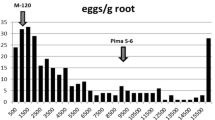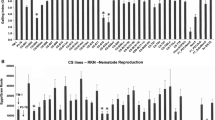Abstract
Root-knot nematodes Meloidogyne incognita (Kofoid and White) can cause severe yield loss in cotton (Gossypium hirsutum L.). The objectives of this study were to determine the inheritance and genomic location of genes conferring root-knot nematode resistance in M-120 RNR, a highly resistant G. hirsutum line with the Auburn 623 RNR source of resistance. Utilizing two interspecific F2 populations developed from the same M-120 RNR by Gossypium barbadense (cv. Pima S-6) cross, genome-wide scanning with RFLP markers revealed a marker on Chromosome 7 and two on Chromosome 11 showing significant association with the resistant phenotype. The association was confirmed using SSR markers with the detection of a minor and a major dominant QTL on Chromosome 7 and 11, respectively. Combined across the two populations, the major QTL on Chromosome 11 Mi-C11 had a LOD score of 19.21 (9.69 and 9.61 for Pop1 and Pop2, respectively) and accounted for 63.7% (52.6 and 65.56% for Pop1 and Pop2, respectively) of the total phenotypic variation. The minor QTL locus on Chromosome 7 Mi 1 -C07 had a LOD score of 3.48 and accounted for 7.7% of the total phenotypic variation in the combined dataset but was detected in only one population. The allele from the M-120 RNR parent contributed to increased resistance in the Mi-C11 locus, but surprisingly, the Pima S-6 allele contributed to increased resistance in the Mi-C07 locus. The M-120 RNR allele in the Mi-C11 locus, derived from the Auburn 623 RNR, is likely to have originated from the Clevewilt 6 cultivar. Results from this study indicated that the SSR marker CIR316 may replace the laborious greenhouse screening in breeding programs to identify genotypes resistant to M. incognita.





Similar content being viewed by others
References
Basten CJ, Weir BS, Zeng ZB (2001) QTL Cartographer, Version 1.15. Department of Statistics, North Carolina State University, Raleigh
Bezawada C, Saha S, Jenkins JN, Creech RG, McCarty JC (2003) SSR marker(s) associated with root knot nematode resistance gene(s) in cotton. J Cotton Sci 7:179–184
Blasingame D, Patel MV (2005) Cotton disease loss estimate committee report. In: Proceedings of Beltwide Cotton Conference, New Orleans, LA. Nat Cotton Counc Am, Memphis, pp 259–262
Bridge J (1992) Nematodes. In: Hollocks RJ (ed) Cotton diseases. CAB Int, Wallingford, pp 33–353
Bridge J, Page SLR (1980) Estimation of root-knot nematode infestation levels on roots using a rating chart. Trop Pest Manage 26:296–298
Burow MD, Simpson CE, Paterson AH, Starr JL (1996) Identification of peanut (Arachis hypogaea L.) RAPD markers diagnostic of root-knot nematode (Meloidogyne arenaria (Neal) Chitwood) resistance. Mol Breed 2:369–379
Chee P, Draye X, Jiang C-X, Decanini L, Delmonte TA, Bredhauer R, Smith CW, Paterson AH (2005) Molecular dissection of phenotypic variation between Gossypium hirsutum and G. barbadense (cotton) by a backcross-self approach: I. Fiber Elongation. Theor Appl Genet 111:757–763
Davis RF, May OL (2003) Relationships between tolerance and resistance to Meloidogyne incognita in cotton. J Nematol 35:411–416
Ehlers JS, Matthews WC, Hall AE, Roberts PA (2000) Inheritance of a broad-based form of root-knot nematode resistance in cowpea. Crop Sci 40:611–618
Grube RC, Radwanski ER, Jahn M (2000) Comparative genetics of disease resistance within the Solanaceae. Genetics 155:873–887
Han ZG, Guo WZ, Song XL, Zhang TZ (2004) Genetic mapping of EST-derived microsallites from the diploid Gossypium arboretum in allotetraploid cotton. Mol Gen Genomics 272:308–327
Han ZG, Wang CB, Song XL, Guo WZ, Gou JY, Li CH, Chen XY, Zhang TZ (2006) Characteristics development and mapping of Gossypium hirsutum derived EST-SSRs in allotetraploid cotton. Theor Appl Genet 112:430–439
Hussey RS, Barker KR (1973) A comparison of methods of collecting inocula of Meloidogyne spp. including a new technique. Plant Dis Rep 57:1025–1028
Kosambi DD (1944) The estimation of map distances from recombination values. Ann Eugen 12:172–175
Lander ES, Green P, Abrahamson J, Barlow A, Daly MJ, Lincoln SE, Newburg L (1987) MAPMAKER: an interactive computer package for constructing primary genetic linkage maps of experimental and natural populations. Genomics 1:174–181
Luzzie BM, Boerma HR, Hussey RS (1994) A gene for resistance to southern root-knot nematode in soybean. J Hered 85:484–486
McPherson MG, Jenkins JN, McCarty JC, Watson CE (1995) Combining ability analysis of root-knot nematode resistance in cotton. Crop Sci 35:373–375
McPherson MG, Jenkins JN, Watson CE, McCarty JC (2004) Inheritance of root-knot nematode resistance in M-315 RNR and M78-RNR cotton. J Cotton Sci 8:154–161
Messeguer R, Ganal M, Devicente MC, Young ND, Bolkan H, Tanksley SD (1991) High-resolution RFLP map around the root-knot nematode resistance gene (MI) in tomato. Theor Appl Genet 82:529–536
Mutschler MA, Doerge RW, Liu SC Kuai JP, Liedl BE, Shapiro JA (1996) Analysis of pest resistance in the wild tomato Lycopersicon pennellii: QTLs controlling acylsugar level and composition. Theor Appl Genet 92:709–718
Nelson JC (1997) QGENE: Software for marker-based genomic analysis and breeding. Mol Breed 3:239–245
Nguyen TB, Giband M, Brottier P, Risterucci AM, Lacape JM (2004) Wide coverage of the tetraploid cotton genome using newly developed microsatellite markers. Theor Appl Genet 109:167–175
Ogallo JL, Goodell PB, Eckert J, Roberts PA (1997) Evaluation of NemX, a new cultivar of cotton with high resistance to Meloidogyne incognita. J Nematol 29:531–537
Park YH, Alabady MS, Sickler B, Wilkins TA, Yu J, Stelly DM, Kohel RJ, El-Shihy OM, Cantrell RG, Ulloa M (2005) Genetic mapping of new cotton fiber loci using EST-derived microsatellites in an interspecific recombinant inbred line (RIL) cotton population. Mol Gen Genomics 274:428–441
Reddy OUK, Pepper AE, Ibrokhim A, Saha S, Jenkins JN, Brooks T, Bolek Y, El-Zik KM (2001) New dinucleotide and trinucleotide microsatellite marker resources for cotton genome research. J Cotton Sci 5:103–113
Reinisch AJ, Dong JM, Brubaker C, Stelly D, Wendel JF, Paterson AP (1994) A detailed RFLP map of cotton (Gossypium hirsutum x Gossypium barbadense): chromosome organization and evolution in a disomic polyploid genome. Genetics 138:829–847
Robinson AF, Cook CG, Percival AE (1999) Resistance to Rotylenchulus reniformis and Meloidogyne incognity race 3 in the major cotton cultivars planted since 1950. Crop Sci 39:850–858
Robinson AF, Bowman DT, Cook CG, Jenkins JN, Jones JE, May LO, Oakley SR, Oliver MJ, Roberts PA, Robinson M, Smith CW, Starr JL, Stewart JM (2001) Nematode Resistance In: Kirkpatrick TL Rothrock CS (ed) Compendium of cotton diseases. The American Phytopathological Society, St. Paul, pp 68–72
Rong JK, Abbey C, Bowers JE, Brubaker CL Chang C, Chee PW, Delmonte TA, Ding X, Garza JJ, Marler BS, Park C, Pierce GJ, Rainey KM, Rastogi VK, Schulze SR, Tronlinde NL, Wendel JF, Wilkins TA, Wing RA, Wright RJ, Zhao X, Zhu L, Paterson AH (2004) A 3347-locus genetic recombination map of sequence-tagged sites reveals features of genome organization, transmission and evolution of cotton (Gossypium). Genetics 166:389–417
Sasser JN, Freckman DW (1987) A world perspective on nematology: The role of the society. In: Veech JA, Dickson DW (eds) Vistas on nematology: a commemoration of the twenty-fifth anniversary of the Society of Nematologists. Society of Nematologists, Hyattsville, pp 7–14
Shepherd RL (1974a) Registration of Auburn 623 RNR cotton germplasm. Crop Sci 14:911
Shepherd RL (1974b) Transgressive segregation for root-knot nematode resistance in cotton. Crop Sci 14:872–875
Shepherd RL, Parrott WL, McCarty JC, Jenkins JN (1989) Notice of release of nine root-knot nematode resistance germplasm lines of upland cotton Gossypium hirsutum L. USDA/Mississippi Agric For Exp Stn Memo
Shepherd RL, McCarty JC, Jenkins JN (1996) Registration of nine cotton germplasm lines resistance to root-knot nematode. Crop Sci 36:820
Van Becelaere G, Lubbers EL, Paterson AH, Chee PW (2005) Pedigree vs. RFLP based genetic similarity estimates in cotton. Crop Sci 45:2281–2287
Wang C, Ulloa M, Roberts P (2006a) Identification and mapping of microsatellite markers linked to a root-knot nematode resistance gene (rkn1) in Acala NemX cotton. Theor Appl Genet 112:770–777
Wang K, Song X, Han Z, Guo W, Yu JZ, Sun J, Pan J, Kohel RJ, Zhang T (2006b) Complete assignment of the chromosomes of Gossypium hirsutum L. by translocation and fluorescence in situ hybridization mapping. Theor Appl Genet 113:73–80
Weiland JJ, Yu MH (2003) A cleaved amplified polymorphic sequence (CAPs) marker associated with root-knot nematode resistance in sugarbeet. Crop Sci 43:1814–1818
Xiao J, Grandillo S, Ahn S, Yuan L, Tanksley SD, McCouch SR (1996) Genes from wild rice improve yield. Nature 384:223–224
Zeng ZB (1994) Precision mapping of quantitative trait loci. Genetics 136:1457–1468
Zhang J, Guo WZ, Zhang TZ (2002) Molecular linkage map of allotetraploid cotton (Gossypium hirsutum L. × Gossypium barbadense L.) with a haploid population. Theor Appl Genet 105:1166–1174
Zhou E, Star JL, Smith CW (1999) Inheritance of resistance to Meloidogyne incognita in the cotton cultivar Acala NemX. J Nematol 31:584–585
Acknowledgments
We thank the Paterson lab for sharing the RFLP probes, the Zhang lab for SSR primer sequences and acknowledge the financial support from the Georgia Cotton Commission and the Cotton Incorporated.
Author information
Authors and Affiliations
Corresponding author
Additional information
Communicated by B. Friebe.
Rights and permissions
About this article
Cite this article
Shen, X., Van Becelaere, G., Kumar, P. et al. QTL mapping for resistance to root-knot nematodes in the M-120 RNR Upland cotton line (Gossypium hirsutum L.) of the Auburn 623 RNR source. Theor Appl Genet 113, 1539–1549 (2006). https://doi.org/10.1007/s00122-006-0401-4
Received:
Accepted:
Published:
Issue Date:
DOI: https://doi.org/10.1007/s00122-006-0401-4




